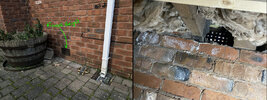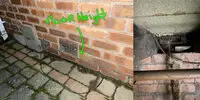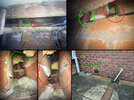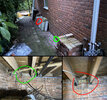- Joined
- 17 Feb 2019
- Messages
- 189
- Reaction score
- 11
- Country

Hi all,
I've been addressing a bunch of issues i've noticed this winter. One of which has been tracking down the source of high humidity (70%+) through the dwelling.
Having setup a bunch of digital temperature / humidity readouts in parallel, i've noticed the highest humidity by some way is down in the crawl space beneath the ground floor. It's at 80%+ (the loft space with vented soffits is 55% comparatively).....anyway i've run a big 400w dehumidifier down there this week, it helped the humidity of the crawl space come down to 60% but within a few days of turning the dehumidifier off its back at 80%+.... i've read online this can be potentially devastating if I leave it so looking to urgently address.
Having crawled around there for most of today (lovely way to spend a Saturday...) I didn't find any leaks or notable dampness which I guess is good. But on the other hand, I also noticed the air down there felt really still and quite musty too, so decided it'd be sensible to investigate the airbricks.
As the property was originally a 1955 bungalow, it has a fairly wide footprint (15m wide, 10m long or so) so I expected to find maybe 2 airbricks on each of the property's faces. But that's not what I found, I only found 5, which I guess isn't the end of the world... but much more concerningly I think only 2 of them are functioning properly either due to not having the appropriate ducting or being bricked over entirely. Photos below.
For ease of reference i've tried to show the positions of the air bricks on the birds eye plan below, along with the rough layout of the walls/honeycomb walls down in the crawl space. I'll show each one (and it's issues) below in numerical order.

AirBrick 1
This one looks as if a front extension was done but no ducting was added, the new extended suspended floor is full of insulation meaning airbrick 1 is never allowing air into the property. I think the solution for this is obvious, needs some ducting, right?

AirBrick 2
This one seemed fine, it's the only airbrick where I could feel a breeze coming through it....and see daylight.... it served as a good barometer for how I expected (and hoped) all the others to be (no such luck)

AirBrick 3
As the block paving slopes up towards the rear of the property this one looks like its been mounted too high? from inside you can see it's only partially visible to the sub floor, also we noticed the way it had been mounted the vents sloped up rather than down. Could it have been mounted upside down? or does this just need a Z vent due to its height? or should we just lower it by a course of brick?

AirBrick 4
The two at the rear of the property (4 and 5) have left me quite concerned. The floor joists run parallel to their openings meaning they're quite obscured, and if that wasn't bad enough, on closer inspection its also obscured by a half brick leaving just 2 small openings for it to vent through.... To fix, shall we remove that half brick and add a Z vent so its vent position will be lower than the floor joist?

Airbrick 5
Same as airbrick 4, couldnt get any closer to get better photos of this one. But the setup looks pretty much the same.

Airbrick 6 & 7
Im assuming the house originally had 2 airbricks down the side here too, as I found what looked like recesses in the inner skin, im wondering if they've just been bricked over by the previous owner..... given the footprint of the property should these be added back in?

Apologies for the long post!... but given the findings above, a few questions in summary.
:- As it stands i don't have any through flow of air....So something needs to be done, right?
:- Are the plans I have for each brick sensible?
:- Given the footprint / subfloor layout of the property, should I add a second air brick on the front?
:- Given what is required to fix the above, would it be better to potentially go with a mechanical / activate ventilation system instead?
Thanks so much, ive no idea what im doing with any of this really so really wanted to make a post. Guidance really appreciated and love to hear any suggestions to help address this as my learnings have all come just from reading stuff online.
thanks again!
Ged
I've been addressing a bunch of issues i've noticed this winter. One of which has been tracking down the source of high humidity (70%+) through the dwelling.
Having setup a bunch of digital temperature / humidity readouts in parallel, i've noticed the highest humidity by some way is down in the crawl space beneath the ground floor. It's at 80%+ (the loft space with vented soffits is 55% comparatively).....anyway i've run a big 400w dehumidifier down there this week, it helped the humidity of the crawl space come down to 60% but within a few days of turning the dehumidifier off its back at 80%+.... i've read online this can be potentially devastating if I leave it so looking to urgently address.
Having crawled around there for most of today (lovely way to spend a Saturday...) I didn't find any leaks or notable dampness which I guess is good. But on the other hand, I also noticed the air down there felt really still and quite musty too, so decided it'd be sensible to investigate the airbricks.
As the property was originally a 1955 bungalow, it has a fairly wide footprint (15m wide, 10m long or so) so I expected to find maybe 2 airbricks on each of the property's faces. But that's not what I found, I only found 5, which I guess isn't the end of the world... but much more concerningly I think only 2 of them are functioning properly either due to not having the appropriate ducting or being bricked over entirely. Photos below.
For ease of reference i've tried to show the positions of the air bricks on the birds eye plan below, along with the rough layout of the walls/honeycomb walls down in the crawl space. I'll show each one (and it's issues) below in numerical order.
AirBrick 1
This one looks as if a front extension was done but no ducting was added, the new extended suspended floor is full of insulation meaning airbrick 1 is never allowing air into the property. I think the solution for this is obvious, needs some ducting, right?

AirBrick 2
This one seemed fine, it's the only airbrick where I could feel a breeze coming through it....and see daylight.... it served as a good barometer for how I expected (and hoped) all the others to be (no such luck)

AirBrick 3
As the block paving slopes up towards the rear of the property this one looks like its been mounted too high? from inside you can see it's only partially visible to the sub floor, also we noticed the way it had been mounted the vents sloped up rather than down. Could it have been mounted upside down? or does this just need a Z vent due to its height? or should we just lower it by a course of brick?

AirBrick 4
The two at the rear of the property (4 and 5) have left me quite concerned. The floor joists run parallel to their openings meaning they're quite obscured, and if that wasn't bad enough, on closer inspection its also obscured by a half brick leaving just 2 small openings for it to vent through.... To fix, shall we remove that half brick and add a Z vent so its vent position will be lower than the floor joist?

Airbrick 5
Same as airbrick 4, couldnt get any closer to get better photos of this one. But the setup looks pretty much the same.

Airbrick 6 & 7
Im assuming the house originally had 2 airbricks down the side here too, as I found what looked like recesses in the inner skin, im wondering if they've just been bricked over by the previous owner..... given the footprint of the property should these be added back in?

Apologies for the long post!... but given the findings above, a few questions in summary.
:- As it stands i don't have any through flow of air....So something needs to be done, right?
:- Are the plans I have for each brick sensible?
:- Given the footprint / subfloor layout of the property, should I add a second air brick on the front?
:- Given what is required to fix the above, would it be better to potentially go with a mechanical / activate ventilation system instead?
Thanks so much, ive no idea what im doing with any of this really so really wanted to make a post. Guidance really appreciated and love to hear any suggestions to help address this as my learnings have all come just from reading stuff online.
thanks again!
Ged
Last edited:

